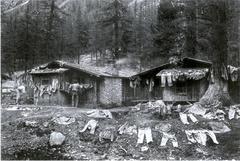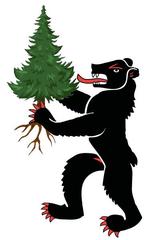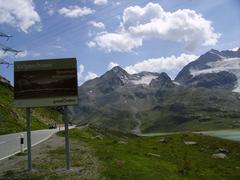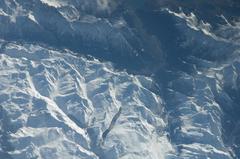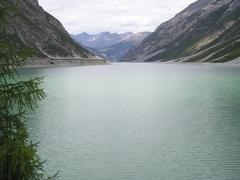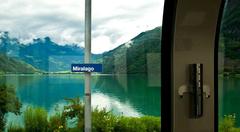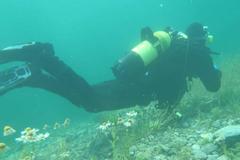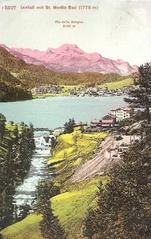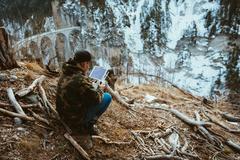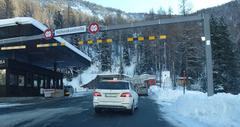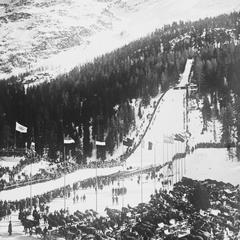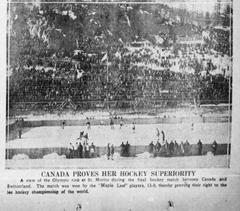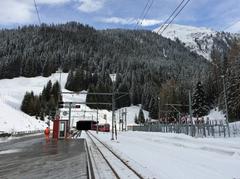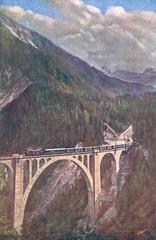
Solavers Castle: Visiting Hours, Tickets, and Travel Guide in Canton of the Grisons, Switzerland
Date: 04/07/2025
Introduction
Perched high above the village of Seewis im Prättigau, Solavers Castle is a remarkable testament to the medieval history and alpine culture of Switzerland’s Canton of the Grisons (Graubünden). Originally constructed in the 11th or early 12th century, this atmospheric ruin once oversaw crucial trade routes between the Rhine Valley and the Engadine, serving both strategic and religious purposes. The remains of its bergfried, curtain walls, and the adjacent Romanesque Church of St. Lawrence provide visitors with a vivid portal into the region’s feudal past.
Today, Solavers Castle is not only a destination for history buffs but also for hikers and cultural travelers eager to blend exploration with panoramic alpine vistas. This guide details the castle’s historical significance, architectural features, practical visiting information, accessibility, tips, and nearby attractions—equipping you with everything you need for an enriching visit (Prättigau Tourism Official Site, Graubünden Tourism, Trip by Trip).
Table of Contents
- History and Cultural Significance
- Architectural Highlights
- Visiting Solavers Castle: Practical Information
- Nearby Attractions
- Special Events and Photo Spots
- Frequently Asked Questions (FAQ)
- Conclusion and Final Tips
- References
History and Cultural Significance
Solavers Castle’s origins trace back to the High Middle Ages. Its location—on a rocky spur above Seewis im Prättigau—provided natural defense and control over key routes through the Prättigau valley. Archaeological evidence suggests the site may have been used as a fortified refuge even earlier, during the late Roman and early medieval periods.
Initially controlled by the Lords of Aspermont in the 12th and 13th centuries, Solavers passed into the hands of the Bishopric of Chur by the late 13th century, reflecting the shifting power dynamics between secular and ecclesiastical authorities. The castle played a significant role during the region’s turbulent formation of the Three Leagues (Drei Bünde) and saw action in the Swabian War of 1499, cementing its strategic importance.
By the 16th century, evolving military technology and the rise of regional alliances rendered hilltop fortresses like Solavers obsolete. The castle was gradually abandoned, with the Church of St. Lawrence remaining a spiritual focal point until the 17th century. Renewed interest in the 19th and 20th centuries led to stabilization and preservation efforts, ensuring the site’s survival as a symbol of Grisons’ medieval heritage.
Architectural Highlights
- Strategic Hilltop Location: The castle’s elevated position on a steep rock outcrop provided defense and sweeping views of the Prättigau valley.
- Curtain Walls and Bergfried: Remnants include sections of the curtain wall (originally about 60 meters), a square bergfried (central tower), and residential quarters arranged to fit the rugged terrain.
- Romanesque Church of St. Lawrence: Adjacent to the castle ruins, the church features distinctive frescoes and an apse, reflecting the site’s dual religious and defensive functions.
- Construction Techniques: Built predominantly from local stone, the castle showcases medieval masonry and Romanesque design elements—thick walls, small arched windows, and functional layouts influenced by Lombard and Tyrolean traditions.
- State of Preservation: Conservation efforts have stabilized key structures; interpretive signage at the site offers historical and architectural context.
Visiting Solavers Castle: Practical Information
Visiting Hours
- Open year-round: The castle ruins and the Church of St. Lawrence are freely accessible at all times. There are no gates or fences restricting entry. For safety and the best experience, visit during daylight hours (Graubünden Tourism).
Tickets and Entry
- Free admission: There are no tickets or fees required to visit the castle ruins. Guided tours, when available through the local tourism office, may require advance booking and a modest fee (Prättigau Tourism Official Site).
Accessibility
- Terrain: Access to Solavers Castle requires a moderate hike along marked trails with uneven, sometimes steep sections. Sturdy footwear is essential. The site is not suitable for visitors with significant mobility challenges.
- Facilities: There are no amenities (toilets, cafés, or shelters) at the castle site itself. Facilities are available in Seewis im Prättigau or Grüsch.
Getting There
- By Public Transport: Take the Rhaetian Railway (RhB) to Seewis-Pardisla or Grüsch. From either station, well-marked hiking trails lead to the ruins (Prättigau.info, Komoot Guide).
- By Car: Park in Seewis im Prättigau or Grüsch and continue on foot via marked trails.
- On Foot: The castle is a highlight on the popular hiking route between Grüsch and Seewis.
Travel Tips
- Best Season: Late spring through early autumn (June–September) offers the best weather and snow-free trails. Winter visits are possible but only for experienced hikers with proper equipment.
- What to Bring: Sturdy hiking boots, weather-appropriate clothing, water, snacks, sun protection, and a camera.
- Guided Tours: Occasionally available through local tourism offices. Book in advance for historical walks or special events.
- Safety: The ruins are unstaffed; exercise caution near cliff edges and uneven surfaces. Supervise children closely.
Nearby Attractions
- Seewis im Prättigau: A charming alpine village with shops and restaurants.
- Other Castles: Explore nearby ruins such as Lichtenstein Castle and Balzers.
- Hiking: Numerous scenic trails offer spectacular views of the Prättigau valley.
- Church of St. Lawrence: Adjacent to the castle ruins, open to visitors.
- Seasonal Events: Occasional medieval festivals and cultural happenings near the castle. Check with the tourism office for schedules.
Special Events and Photo Spots
- Photo Opportunities: Capture panoramic views of the Prättigau valley from the castle walls and the bergfried.
- Events: Cultural events and guided historical walks are organized seasonally. Visit the Prättigau Tourism Official Site for updates.
Frequently Asked Questions (FAQ)
Q: What are the opening hours of Solavers Castle?
A: The ruins are open year-round, accessible at any time. Daylight visits are recommended.
Q: Is there an entrance fee?
A: No, visiting is free of charge.
Q: Is the castle accessible for those with limited mobility?
A: The trails are steep and uneven, making the site unsuitable for visitors with significant mobility restrictions.
Q: Are guided tours available?
A: Occasionally, through local tourism offices; advance booking is recommended.
Q: What is the best time to visit?
A: June through September for the best weather and trail conditions.
Q: Are dogs allowed?
A: Yes, but they must be kept on a leash.
Conclusion and Final Tips
Solavers Castle is a captivating blend of medieval history and natural beauty in the heart of the Grisons. Its freely accessible ruins, dramatic setting, and proximity to picturesque alpine villages make it a must-see for travelers seeking both culture and adventure. Prepare for a moderate hike, respect the preserved ruins, and take time to enjoy the stunning vistas and historical context provided by this unique Swiss heritage site.
For the latest updates on events, trail conditions, and guided tours, consult the Prättigau Tourism Official Site and Graubünden Tourism portal. To enrich your visit, download the Audiala app for immersive audio guides and interactive maps.
References
- Prättigau Tourism Official Site
- Graubünden Tourism
- Trip by Trip: The Grisons or Graubünden
- Praettigau.info: Castle Ruins of Solavers
- Studying in Switzerland: Castles in Switzerland
- Komoot Hiking Guide
- Seewis im Prättigau Tourism Office
- Wikipedia: Solavers Castle
- Claudia Travels: Things to Do in Grisons
Image suggestions:
- Photos of Solavers Castle ruins with alt text “Solavers Castle ruins in Grisons, Switzerland.”
- Panoramic views from the castle: “Panoramic view of Prättigau valley from Solavers Castle.”
- Maps showing the castle’s location and hiking routes.
Plan your visit today and experience the history and natural splendor of Solavers Castle!





